The R/V Thomas G. Thompson left Honolulu on November 5, 2011 heading toward the Western Pacific. This expedition journal was written by cruise participants and uploaded about once per weekday, depending on internet availability.
December 14, 2011: Weather and Reporting
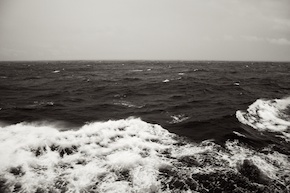
Getting rough (Credit: Will Koeppen)
"Bungee that down! The Commander predicts 12–15 footers for the next two days! That means no Sentry and it looks like we'll just be doing bathymetry for now.” “Why was nobody at dinner, you missed Justin's chair sliding across the whole room?” “This bathymetry really sucks!” All these can be heard from the passengers on the R/V Thomas G. Thompson as bad weather puts our meticulously pre-planned operation on hold. A good scientific expedition requires mostly drama-free operations, which are practically impossible to achieve during a spot of dodgy seas. That is why chief scientists must keep a watchful eye on the sea conditions and always have a plan B, and usually plans C, D, and E ready to go.
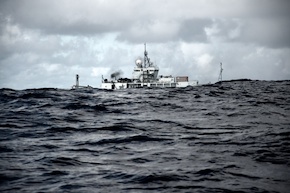
There we go (Credit: Will Koeppen)
One problem about being in the open ocean is that, even in this day and age, it is rather difficult to get an accurate local weather prediction. You can’t just plug our latitude and longitude into weather.com. That was hard for me to believe at first, but it made sense when I thought about the size and remoteness of our study area. There is no practical reason why there would be a huge Doppler radar system giving us the “Local on the 8s” for our next day’s location, when we could very well be the only intelligent life in the Jurassic Quiet Zone. So, a few weeks ago, I was dumbfounded when Maurice Tivey told me that a storm was going to hit us the next day. I walked outside to see if there were dark clouds on the horizon that maybe gave it away, but there were none, it was bright and sunny. Of course, if I could already see the storm, it wouldn’t wait until the next day to get to us. The thought crossed my mind that Maurice was playing a prank on me. However, when I pressed him further, Maurice presented me a map of the Pacific Ocean labeled with some current wind directions and sea states. This surprised me, where did it come from?
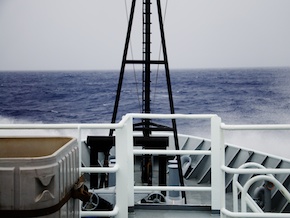
Not closed yet (Credit: Will Koeppen)
The Thompson requires a lot of shore-side support for weather information. The National Oceanographic and Atmospheric Administration (NOAA) interprets wind direction, wind speed, and even wave height from satellite data. In addition they collect information about current weather conditions from ships, which they cross-reference with satellite data for accuracy. This means that the R/V Thompson also serves as a floating weather station. Every hour, mates on the bridge will report to NOAA on our local weather conditions: barometric pressure, temperature, average wave height, wind speed and direction. A few of times per day, they will print out a weather map from NOAA with a satellite image of our area, the locations of any nearby ships, and what kind of weather those ships are reporting. On top of that, the science team pays for the "Commanders' Weather" report. Commanders' Weather is a commercial company that dishes out personalized weather reports for racing and cruising yachts, along with the occasional research vessel. Twice per day we receive an email that gives us a detailed five-day weather forecast. With these weather prediction techniques, we are able to prepare for storms in advance. They are a lifesaver when our ability to put all of our expensive equipment to use and collect data depends inexorably on the weather.
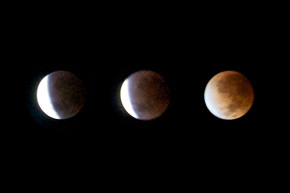
Clear + lunar eclipse (Credit: Will Koeppen)
Even though we know several days in advance that the seas may get angry at us, ‘The Commander’ or NOAA do not tell us how to “keep the science flowing”, as the crew commonly puts it. Luckily we haven’t been burdened too much by bad weather, but there were two significant storm events near the beginning of the cruise that impacted the total area of Jurassic Crust that we were able to survey. While everyone was either struggling to keep their lunch down or in a sea-sickness-medication-induced coma, the chief scientists, techs, and the captain had to come up with a plan that would maximize the amount of deep-ocean surveying that could be done given the conditions. They had to take into account the fact that each science operation has unique constraints to consider. For example, it is difficult and dangerous to recover Sentry in a choppy or confused sea-state. Because the AUV can dive for over 24 hours, we can deploy under sunny skies and flat seas but when it comes time to retrieve it, conditions may have changed for the worse. We also can't deploy TowCam in heavy seas because the bouncing of the ship can put too much tension on the cable and block attaching it to the sled. The seismic gear can be put out under most conditions; however, quality of the seismic data decreases with increased sea-state. The surface-towed Maggie is the only instrument we use that is relatively weather resistant.
Though the chief scientists refine our survey plan based on the weather forecast, ultimately it is the captain that makes the final call on what can be done. He must decide where to draw the line between a situation in which rough seas are just a minor inconvenience and one in which they can become dangerous for science operations. The captain has the power to steer the ship off course to avoid a storm that could threaten our safety. If it's not necessary to leave the area, he can still ban us from going outside on deck, where waves could crash over the railings and sweep you away.
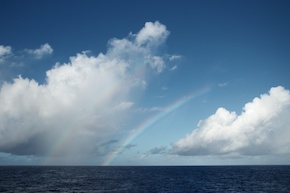
Boring weather (Credit: Will Koeppen)
Thankfully, something that I’ve noticed about the weather here in the tropics is that bouts of high wind and heavy precipitation are short-lived, making them relatively easy to deal with. The sea-state and swells seem to linger, but we've been able to adapt to these conditions. When all is said and done, we have gathered gobs of precise data even while pitching, rolling, and yawing on a dynamic surface — the ocean. In addition, we've had relatively "boring" weather for the second half of this cruise. As a tall and wise R/V Thompson engineer once told me in reference to how smoothly this trip has gone, "boring is beautiful". ♦
